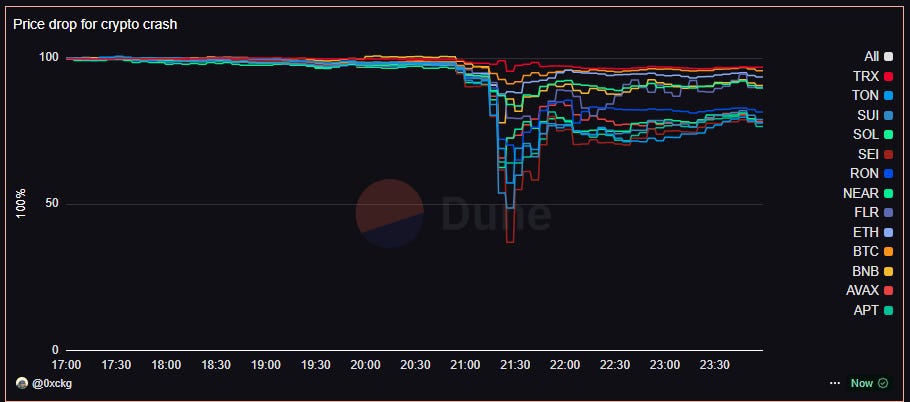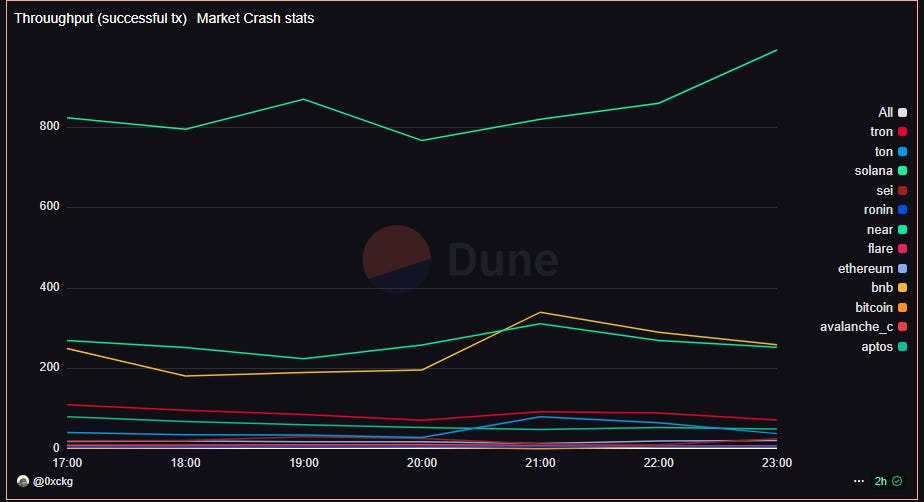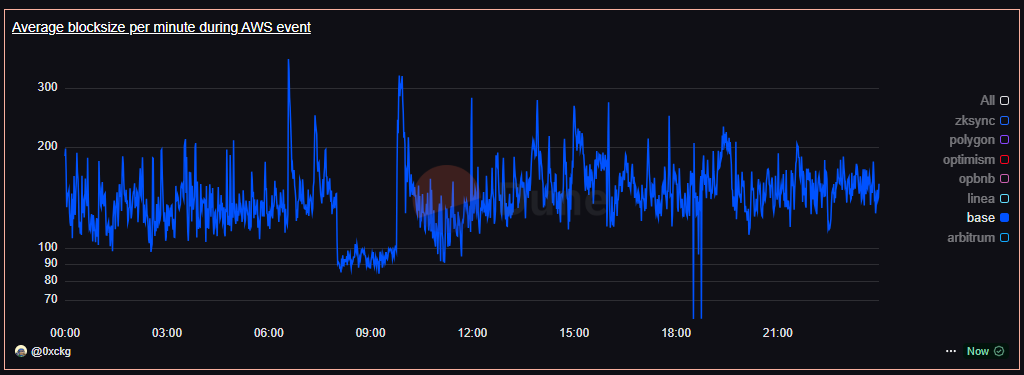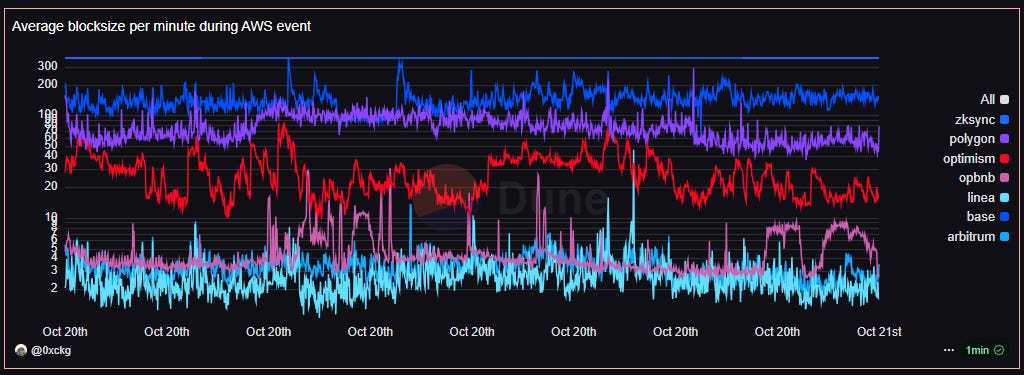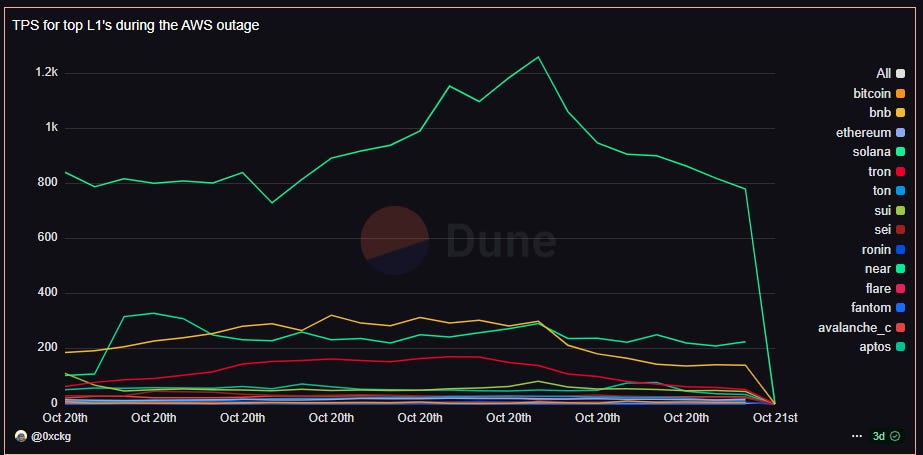A Technical Impact Report of The AWS Outage and Recent Crypto Market Crash
Introduction
On October 10, 2025, the cryptocurrency market experienced a sudden, sharp downturn that wiped billions off the market capitalization of major assets. Just ten days later, on October 20, 2025, a major AWS (Amazon Web Services) outage disrupted some blockchain infrastructure worldwide. The crypto market crash highlighted the volatility and sensitivity of blockchain ecosystems to external financial pressures. At the same time, the AWS outage 10 days later revealed the underlying fragility and interdependence between cloud infrastructure and decentralized systems.
This report analyzes Blockchain performance data during the Crypto market crash and AWS outage. It compares it to the previous day to visualize how events impacted transaction flow, throughput, and block propagation across major L1s and L2s.
Crypto Market Crash
The crypto market crash on October 10, 2025, began shortly after the release of unexpected U.S. inflation data, which triggered sell-offs across equities and crypto markets. Bitcoin fell nearly 12% in a few hours, Ethereum dropped 15%, and several altcoins plunged by 20–50%.
The crash triggered liquidations of leveraged positions, especially in perpetual futures markets. As centralized exchanges throttled transaction processing and raised margin requirements, on-chain activity also declined.
Price drop during market crash
Impact on Blockchain Metrics
Network-level data showed that the market crash triggered a surge in on-chain activity. The rapid price drop led to increased transaction volume as traders rushed to close positions, adjust collateral, and move assets across chains. This sudden influx stressed mempools, increased gas fees, and momentarily slowed block propagation on several networks.
Transaction Throughput (TPS) and Efficiency:
Throughput here is defined as the number of successful transactions per second (TPS).
Ethereum dropped from ~18 to ~15 TPS as transactions slowed, then shot up to ~20 TPS, with a throughput efficiency of 98%
BNB Chain efficiency fell by 12%, with transaction throughput at ~385 TPS.
Solana experienced a decline in efficiency to about 40% but still reached ~860 TPS during the peak of the crash, making it the blockchain with the highest TPS during the crash.
Bitcoin’s throughput crashed to ~1 TPS, and fees rose sharply due to congestion.
Other L1s faced a decline in their throughput efficiency to ~5% to 30%.
Note: Throughput Efficiency (%) = (Successful Transactions / Total Transactions) × 100
Transaction Count:
L1 transaction volume increased by 20–120% during the market crash.
Solana Chain recorded the most significant increase in transaction volume..
L2 networks like Base saw a 50% decline, mirroring the retreat in Ethereum layer activity.
Behavioral Observations
The crypto crash exposed economic fragility rather than technical weakness. Nodes and validators stayed online; consensus remained stable. The slowdown reflected human and algorithmic responses to financial stress, not infrastructural failure.
DeFi protocols paused, liquidations surged, and transaction-priority fees temporarily spiked due to panic-induced gas competition. Once prices stabilized around October 11, throughput metrics returned to baseline within 12–18 hours.
AWS (Amazon Web Services) Outage
Unlike the market crash, the AWS outage directly tested blockchain infrastructure itself. Beginning around 07:00 UTC on October 20, it affected multiple AWS regions, especially US-East-1, where large portions of blockchain RPCs, indexers, and sequencers are hosted.
While many L1 validators run independently on diversified hardware, several L2 sequencers and API services rely heavily on AWS. This caused immediate latency spikes, missed transactions, and stalled block confirmations across affected networks.
Impact on Blockchain Metrics
Transaction Throughput (TPS)
Layer 1 Impact:
Ethereum: TPS dropped from 14 to 7 during the peak outage.
BNB Chain: Down by 35%, with visible transaction clustering post-restoration.
Avalanche and Fantom: Fell 40–50%, showing reliance on AWS RPCs.
Solana: Dropped ~15%, but quickly reversed as tiny percentage of its nodes rely on AWS
Bitcoin, Ton, and Near: Showed no measurable performance change, proof of infrastructural independence.
Layer 2 Impact (Blocksize):
Base nearly flatlined between 07:00–10:00 UTC.
Arbitrum and Optimism declined ~25%.
Linea and Mantle recorded almost no new transactions during outage hours.
Polygon experienced only transient latency.
zkSync data remained flat due to incomplete reporting of block size metrics.
Highlighting Base’s chain performance during the outage. Full chart here
Transactions per second (failed+successful tx)
Transactions per second during the AWS outage
Across all analyzed blockchains, hourly transaction counts dropped by 30%-50% during the 07:00–12:00 UTC window.
Once AWS restored service, backlogged transactions were processed in rapid bursts, visible as TPS spikes across multiple networks.
Key Findings
1. Centralization Risks: Over 70% of major L2 sequencers and RPC nodes run on AWS.
2. Layer 1 Resilience: Bitcoin, Solana, and Near demonstrated genuine decentralization, sustaining consistent throughput despite outages.
3. Layer 2 Vulnerability: Base was the most impacted, showing its heavy dependence on the AWS cloud service.
4. Recovery Behavior: Post-outage bursts show that blockchain systems can self-heal when external services stabilize but rely heavily on centralized coordination.
5. Data Limitations: zkSync and Fantom exhibited incomplete size logs, indicating the need for standardized, transparent telemetry across chains.
Conclusion
The October 10 crypto crash and October 20 AWS outage were fundamentally different yet complementary in what they revealed. The crash demonstrated that decentralized finance is not immune to macroeconomic gravity; fear, leverage, and liquidity still dictate activity.
The outage, meanwhile, proved that technical decentralization remains incomplete, with much of the blockchain world still reliant on centralized cloud infrastructure.
For the crypto ecosystem to evolve into a truly independent network layer, it must address two dependencies:
Economic: Reducing leverage-driven volatility and speculative fragility.
Infrastructural: Decentralizing hosting, RPC access, and sequencer operations.
Until then, blockchains will continue to mirror the world they were built to transcend, financially volatile and technically centralized.
REFRENCES
All chary data was obtained from Kage's Dune profile


